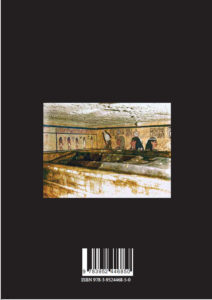Die Geschichte des Nachbaus von Tutanchamuns Grab und die Bedeutung der Bilder in seiner Grabkammer

von Theodor Abt
Living Human Heritage Publications, Zurich 2017.
ISBN 978-39524468-5-0
143 Seiten mit 110 überwiegend farbige Abbildungen.
Dieses Buch ist eine Einführung für die Besucher des Faksimile-Grabes von Tutanchamun. Teil 1 beginnt mit einem allgemeinen Überblick, was wir der altägyptischen Kultur zu verdanken haben. Teil 2 erzählt die Geschichte des Nachbaus von Tutanchamuns Grab. Im letzten Teil 3 folgt ein Überblick über das Bildprogramm in der Grabkammer, zusammen mit den dazugehörigen Texten. Abschließend folgt eine Erläuterung der Darstellungen auf den vier vergoldeten Schreinen, welche um den Sarkophag herum aufgebaut worden waren. Diese stehen heute im Museum in Kairo. Bilder und Texte sollten dem verstorbenen Pharao Tutanchamun die nötige Orientierung geben, damit er in seinem Grab zu neuem Leben als Re-Osiris auferstehen konnte. Je mehr wir über den tieferen Sinn solcher Orientierungshilfen in solchen Pharaonengräbern erfahren, desto besser können wir deren Bedeutung für uns heute erkennen. Und je besser wir uns mit dem Wert dieses Jenseitswissens der Alten Ägypter vertraut machen, umso mehr werden wir diese Schätze der Vergangenheit für zukünftige Generationen nachhaltig schützen wollen.
>> Bestellung
Auch auf Englisch verfügbar: Tutankhamun – Reviving Egypt’s Past for the Future.

Inhaltsverzeichnis
Vorwort von Antikenminister Prof. Dr. Mamdouh Eldamaty 7
Einleitung 9
Teil I: Was wir dem Alten Ägypten verdanken 11
1. Ägypten – von Mutter Natur beschützt 13
2. Die erste Hälfte der Menschheitsgeschichte –
vor allem im Alten Ägypten geschrieben 15
3. Männliches und Weibliches Prinzip – gleichwertig 17
4. Altägyptisches Verständnis von Nachhaltigkeit – über 3000 Jahre erfolgreich 19
5. Die erfolgreiche Bewältigung einer Krise – Tutanchamun und Ma’at 21
6. Die Reise des Sonnengottes zu seiner Erneuerung 23
7. Im Gefolge des Sonnengottes kann ewige Verjüngung erlangt werden 25
Teil II: Wie es zur Schaffung der Faksimiles altägyptischer Gräber kam 27
1. Das Problem des Massentourismus 29
2. Vom Problem zu einer möglichen Lösung 31
3. Das Grab des Pharao Thutmosis III. als Faksimile 33
4. Das Grab des Tutanchamun als Faksimile 35
5. Die Entstehungsphasen des Tutanchamun-Faksimiles 37
6. Die Faksimiles der Gräber von Sethos I. und Königin Nefertari 47
7. Arbeitsplätze für Ägypter schaffen 49
Teil III: Das Grab des Pharao Tutanchamun – Bilder und Texte in der Grabkammer 55
1. Das Grab des Pharao Tutanchamun im Überblick 56
2. Wer war Tutanchamun? 59
3. Wie Tutanchamuns Grab entdeckt wurde 61
4. Die Grabkammer wird geöffnet 63
5. Einführung zum Sinn der Wandbilder 65
6. Die Ostwand 66
7. Die Nordwand 74
8. Die Südwand 84
9. Die Westwand 88
10. Südwand, linke Seite 95
11. Die vier Schreine um den Quarzitsarkophag 97
12. Der kleinste Schrein IV 99
13. Schrein III 107
14. Schrein II 111
15. Das Bahrtuch 115
16. Schrein I 117
17. Der Quarzitsarkophag 121
18. Die drei Särge im Sarkophag 123
19. Die goldene Totenmaske 125
Teil IV: Anhang 127
1. Zeittafel – Könige des Neuen Reichs 128
2. Ausgewählte Literatur 129
3. Abbildungsverzeichnis 132
4. Glossar 136
5. Index 139


 Translated into English by Erik Hornung
Translated into English by Erik Hornung Translated by David Warburton
Translated by David Warburton
 WHY THE AMDUAT IS SIGNIFICANT
WHY THE AMDUAT IS SIGNIFICANT